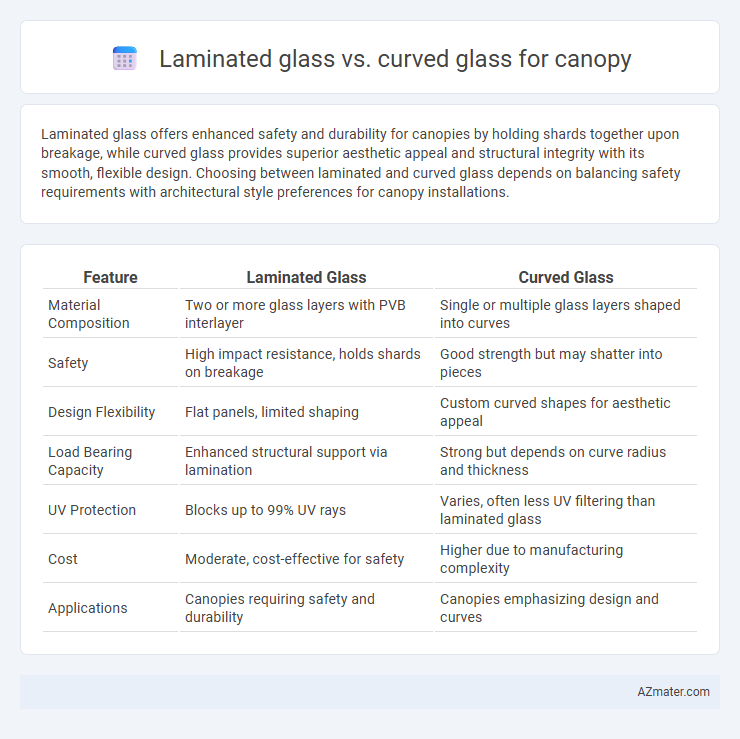Laminated glass offers enhanced safety and durability for canopies by holding shards together upon breakage, while curved glass provides superior aesthetic appeal and structural integrity with its smooth, flexible design. Choosing between laminated and curved glass depends on balancing safety requirements with architectural style preferences for canopy installations.
Table of Comparison
| Feature | Laminated Glass | Curved Glass |
|---|---|---|
| Material Composition | Two or more glass layers with PVB interlayer | Single or multiple glass layers shaped into curves |
| Safety | High impact resistance, holds shards on breakage | Good strength but may shatter into pieces |
| Design Flexibility | Flat panels, limited shaping | Custom curved shapes for aesthetic appeal |
| Load Bearing Capacity | Enhanced structural support via lamination | Strong but depends on curve radius and thickness |
| UV Protection | Blocks up to 99% UV rays | Varies, often less UV filtering than laminated glass |
| Cost | Moderate, cost-effective for safety | Higher due to manufacturing complexity |
| Applications | Canopies requiring safety and durability | Canopies emphasizing design and curves |
Introduction to Canopy Glass Options
Canopy glass options primarily include laminated glass and curved glass, each offering distinct benefits for structural and aesthetic purposes. Laminated glass provides enhanced safety and impact resistance due to its interlayer that holds shards together when broken, making it ideal for protective overhead installations. Curved glass offers customizable shapes and sleek modern designs, allowing architects to create flowing canopy structures with both durability and visual appeal.
What is Laminated Glass?
Laminated glass for canopies consists of two or more glass layers bonded by an interlayer, usually polyvinyl butyral (PVB), which enhances safety by preventing shattering upon impact. This construction provides superior strength, UV protection, and acoustic insulation compared to ordinary glass, making it a reliable choice for overhead canopies exposed to weather and impact hazards. In contrast, curved glass offers aesthetic appeal and custom shaping but lacks the inherent safety benefits of laminated glass.
What is Curved Glass?
Curved glass is a type of architectural glass that is heated and bent to create smooth, rounded shapes, commonly used in canopies for aesthetic appeal and structural functionality. Unlike laminated glass, which is composed of multiple layers bonded for strength and safety, curved glass offers enhanced visual fluidity and customizability in design without compromising durability. Its unique shaping process allows for seamless integration into modern canopy structures, improving both weather resistance and style.
Strength and Durability Comparison
Laminated glass offers superior strength and safety due to its interlayer, which holds shards together upon impact, making it ideal for canopies requiring high durability and impact resistance. Curved glass provides enhanced structural integrity by distributing stress evenly across its shape, improving load-bearing capacity and resistance to deformation under pressure. Both materials exhibit excellent durability, but laminated glass excels in shatter resistance while curved glass is favored for its ability to withstand wind loads and architectural stresses in canopy applications.
Safety Features: Laminated vs Curved Glass
Laminated glass boasts superior safety features for canopies due to its interlayer that holds shattered pieces together, reducing the risk of injury from broken glass. Curved glass, while aesthetically appealing and structurally strong, typically lacks the same impact resistance unless combined with laminated technology. Choosing laminated curved glass combines the benefits of both, offering enhanced safety and durability for canopy installations.
Design Flexibility and Aesthetics
Laminated glass offers superior design flexibility for canopies by allowing integration of various interlayers that enhance color, texture, and safety, creating visually striking and customizable aesthetic options. Curved glass provides dynamic and seamless architectural appeal with its smooth, continuous form that enhances the canopy's modern look while allowing for unique shapes that blend functionality with elegance. Both materials deliver distinct aesthetic advantages; laminated glass focuses on layered design versatility, whereas curved glass emphasizes fluidity and sculptural form in canopy design.
UV Protection and Energy Efficiency
Laminated glass canopy offers superior UV protection by incorporating a polyvinyl butyral (PVB) interlayer that blocks up to 99% of harmful ultraviolet rays, reducing interior fading and skin damage. Curved glass, while aesthetically appealing, typically requires additional coatings or treatments to match the UV defense capabilities of laminated glass. Energy efficiency in laminated glass is enhanced through its insulating properties, which minimize heat transfer and improve temperature regulation under the canopy, whereas curved glass's shape may affect solar heat gain depending on the glass type and curvature radius.
Installation and Maintenance Considerations
Laminated glass canopies require precise handling during installation to prevent delamination and ensure the interlayer remains intact, often necessitating specialized adhesives and support structures. Curved glass installations demand advanced framing systems and expert labor to accommodate their unique shapes, ensuring proper load distribution and weather sealing. Maintenance for laminated glass typically involves regular inspection of the interlayer for clouding or damage, while curved glass may require more frequent seal checks and cleaning to preserve clarity and structural integrity.
Cost Analysis: Laminated vs Curved Glass Canopies
Laminated glass canopies generally offer a more cost-effective solution compared to curved glass due to lower manufacturing and installation expenses. Curved glass requires specialized fabrication processes and custom molds, significantly increasing the overall project cost. Maintenance costs are often higher for curved glass canopies as well, making laminated glass the preferred option for budget-conscious canopy designs.
Choosing the Right Glass for Your Canopy Needs
Laminated glass offers enhanced safety and durability for canopy applications, featuring multiple layers bonded with an interlayer that holds shards in place upon breakage. Curved glass provides aesthetic appeal and design flexibility, allowing seamless integration into modern architectural styles with smooth, flowing lines. Selecting the right glass depends on priorities like impact resistance, visual design, and structural requirements for your canopy project.

Infographic: Laminated glass vs Curved glass for Canopy
 azmater.com
azmater.com